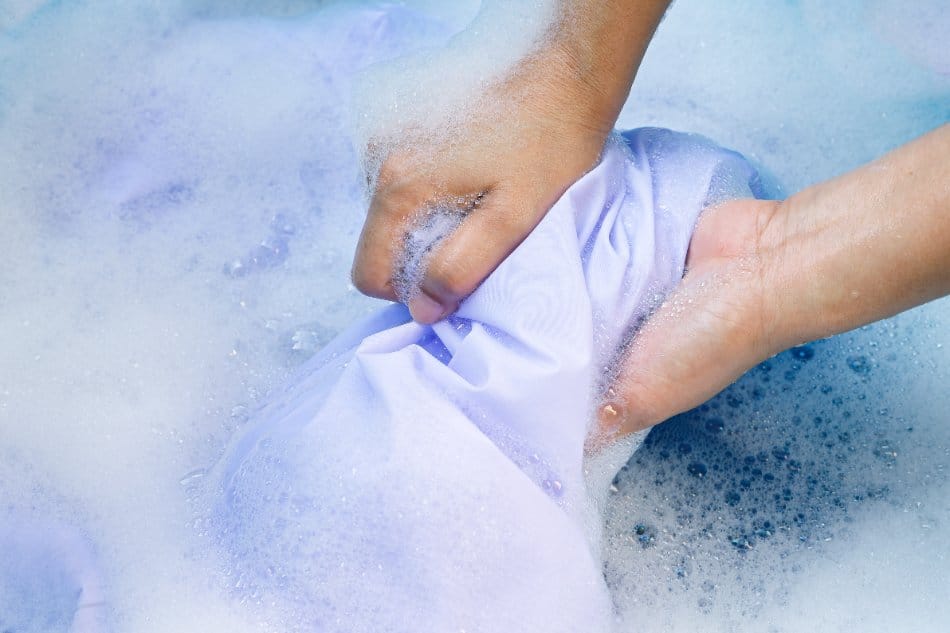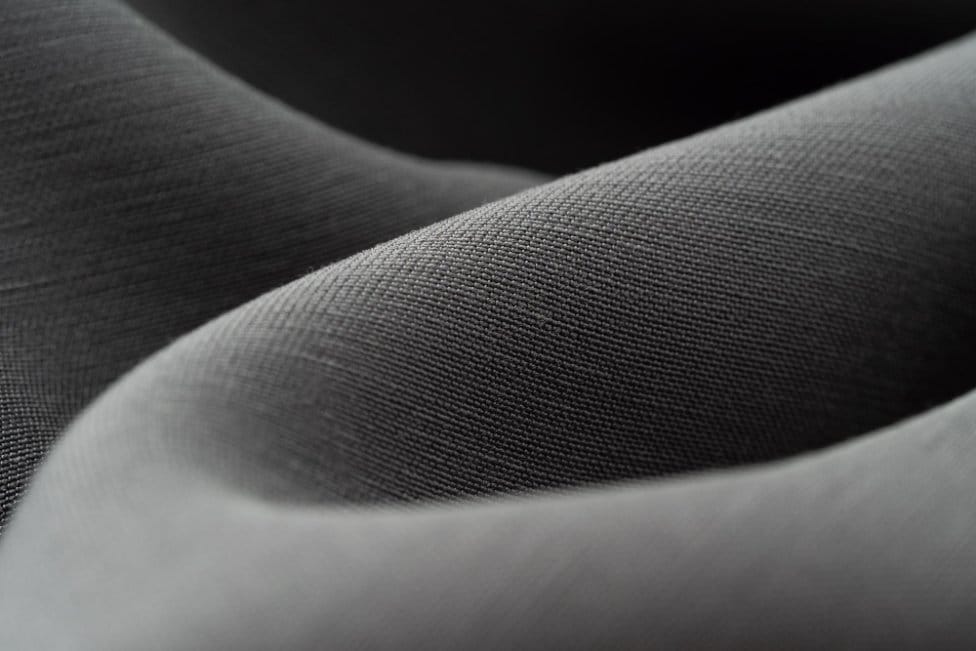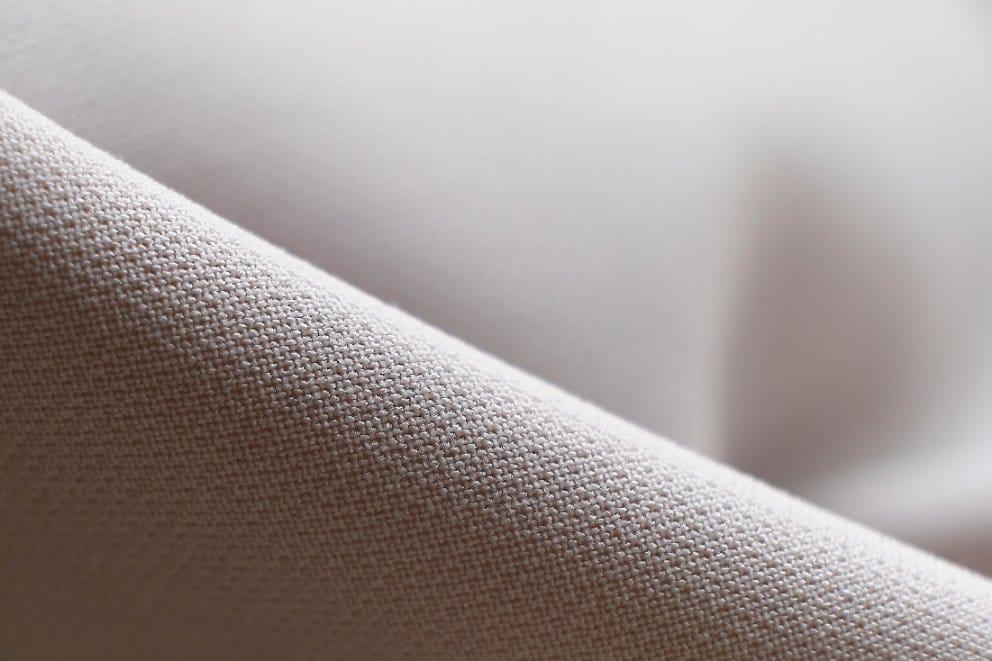Master Polyester Care: Complete Washing, Drying & Stain Removal Guide for Long-Lasting Fabrics
Washing 100% polyester is simple and doesn’t take much special effort. You can wash polyester in cold or warm water using a regular wash cycle and standard laundry detergent, then hang it to dry or tumble dry on low. This routine will help keep your clothes clean and in good shape.
Many polyester items come with care labels, so it helps to check those before washing. If your garment has stains or odors, a gentle soak or pre-treating them can lift spots without harming the fabric. Polyester is strong and resists wrinkles, so it’s easy to include in your weekly laundry.
Key Takeaways
- Polyester is easy to clean with regular washing and drying methods
- Always check the care label before cleaning polyester
- Treat stains early for the best results
- Use cool to warm water to prevent fiber damage
- Low heat drying prevents shrinkage and melting
Understanding Polyester Fabric
Polyester is a very common fabric found in clothes, bedding, and household items. Its properties make it easy to care for, but it still has some limits compared to natural fibers like cotton and wool.
What Is Polyester?
Polyester is a type of synthetic fiber made mostly from petroleum. It is created in labs through a chemical process, which makes it different from natural fibers like wool, cotton, or silk.
This fiber is woven or knitted to make polyester fabric. Polyester can be made into fabric by itself or blended with other fibers, such as cotton or rayon, to create material that combines different qualities.
You’ll often see polyester used in shirts, pants, jackets, dresses, and even sportswear. Many items labeled as “polyester blend” or “cotton-polyester blend” use both synthetic and natural fibers to balance durability, comfort, and breathability.
Benefits and Drawbacks of Polyester
Benefits:
- Durable: Polyester is strong and resists shrinking, stretching, and wrinkles
- Quick-drying: It dries much faster than natural fibers like cotton or wool
- Easy to wash: Most polyester fabrics can be machine washed and dried without special steps
- Resistant: It holds up well to regular wear and maintains its shape over time
- Affordable: Generally costs less than natural fiber alternatives
- Color retention: Holds vibrant colors even after multiple washes
Drawbacks:
- Retains Odor: Polyester can trap odors more easily than natural fibers
- Less Breathable: It may feel warmer and less comfortable in hot weather because it doesn’t let air through as well
- Melt Risk: High heat can melt polyester, so caution is needed when using an iron or dryer
- Static buildup: Can create static cling, especially in dry conditions
- Environmental impact: Made from petroleum and releases microplastics when washed
Polyester vs. Other Fabrics
| Property | Polyester | Cotton | Wool | Nylon | Silk | Rayon |
|---|---|---|---|---|---|---|
| Made from | Synthetic | Natural | Natural | Synthetic | Natural | Semi-synth. |
| Wrinkle resistance | High | Low | Medium | High | Low | Low |
| Durability | High | Medium | High | High | Low | Low |
| Breathability | Low | High | High | Low | High | High |
| Drying Speed | Fast | Slow | Slow | Fast | Slow | Medium |
| Heat sensitivity | High | Low | Medium | High | Medium | Medium |
| Care difficulty | Easy | Easy | Hard | Easy | Hard | Medium |
Polyester is stronger and more wrinkle-resistant than cotton, silk, or rayon. It is also less likely to shrink than wool. However, it does not breathe as well, which can make it less comfortable in hot climates. Nylon is another synthetic that shares many traits with polyester, though nylon is stretchier.
Can You Wash Polyester Clothes?
Yes, you can absolutely wash polyester clothes. In fact, polyester fabric is designed to be machine washable and easy to care for. Most 100% polyester items can handle regular washing without special treatment. The key is using the right water temperature and gentle handling to keep the fabric looking its best.
Does Polyester Wrinkle?
Polyester is naturally wrinkle-resistant, which is one of its biggest advantages. Unlike cotton or linen, polyester clothes come out of the wash looking smooth and ready to wear. However, if wrinkles do appear, they’re usually easy to remove with low heat or steam.
Reading Care Labels for Polyester

Reading the care label on your polyester garment helps you avoid mistakes like shrinking, fading, or fabric damage. Care labels show you the best way to wash, dry, and care for your clothes.
How to Interpret Washing Instructions
The care label on polyester clothing will tell you exactly how to wash it. Labels may say “machine wash cold” or “wash with like colors.” Always check for phrases like “gentle cycle,” “do not bleach,” or “tumble dry low.” These warnings help you know the safest settings and if you should avoid heat or harsh chemicals.
Look for the recommended water temperature. Cool or cold water is usually safest for polyester. If the label says “hand wash only,” avoid using the machine. If “do not iron” is listed, skip the iron to prevent melting or warping.
When you follow the label, you protect the color, shape, and feel of your polyester clothes. Ignoring the label can cause problems like damage or shrinking.
Symbol Meanings for Polyester Garments
Labels often use small care symbols to show washing and drying steps. Learning what these symbols mean is important for polyester care.
Common symbols for washing include a bucket of water (which shows machine washing is allowed) and a hand in water (which means hand wash only). A triangle with an “X” means “do not bleach.” A circle inside a square shows tumble drying is allowed, and dots inside the symbol tell you how much heat to use (one dot is low, two is medium).
An iron with a single dot means you can iron on low heat. If you see an “X” over the iron, do not use any heat on the fabric. Always double check these symbols to avoid damaging your polyester item.
Identifying ‘Dry Clean Only’ Polyester
Some polyester items will say “dry clean only” on the care label. This means you should not put them in a washing machine or hand wash them at home. The fabric might shrink, lose its shape, or become damaged if wet-washed.
Look for the word “dry clean only” or a circle symbol, sometimes with the letter “P” or “F” inside. These marks tell you to take the item to a professional cleaner.
If you ignore a “dry clean only” label, your polyester piece could have permanent creases, lose its finish, or even fall apart at the seams. Always follow this instruction if it appears on your care label.
Machine Washing 100% Polyester

You can safely wash 100% polyester in a washing machine by following specific steps for water temperature, cycle selection, and detergent use. Using the right laundry tips protects your polyester fabric and helps it last longer without fading or shrinking.
Setting the Right Wash Cycle
Always set your washing machine to a normal or delicate cycle when washing polyester clothing. The gentle cycle is preferable for lightweight or loosely woven polyester fabrics.
A gentle cycle reduces agitation, which helps keep fibers from pilling or becoming worn. If the item is stained or especially dirty, you can use the normal cycle unless the care label warns against it.
Heavy or bulky polyester, like jackets and blankets, can handle the normal cycle. Still, always check the label before washing any polyester fabric. Using the correct cycle prevents unnecessary damage.
Choosing the Best Water Temperature
Set the washing machine to use cold or warm water for polyester. Cold water is safest and helps prevent shrinking and color fading. Warm water can be used for items with tough stains, but avoid hot water because heat weakens polyester fibers.
To keep things simple, here’s a reference table:
| Water Temperature | When to Use | Benefits | Risks |
|---|---|---|---|
| Cold (60-80°F) | Everyday washing, bright colors | Prevents shrinking, saves energy | May not remove tough stains |
| Warm (90-110°F) | Stains, light soil, athletic wear | Better cleaning power | Slight shrinkage risk |
| Hot (130°F+) | AVOID for polyester | N/A | Melting, severe shrinkage |
Always double-check the care label first. Using the wrong temperature may damage the fabric or change its shape.
Selecting Gentle Laundry Detergent
Choose a gentle or mild laundry detergent when you wash polyester in the washing machine. Regular, unscented liquid detergents are usually best. Avoid bleach and harsh chemicals, as they can break down the synthetic fibers and damage your polyester clothing.
Tips:
- Use the recommended amount of detergent as listed on the package
- If your polyester has stains, pretreat with a small amount of liquid detergent before placing it in the wash
- Powder detergents can leave residue on polyester, so liquid options are a better choice for a cleaner finish
- For athletic wear, consider detergents designed for synthetic fabrics
Tips for Washing Multiple Polyester Items
Wash similar colors and types of polyester fabric together to avoid color bleeding and pilling. Lighter items can snag in the machine, so place delicate polyester clothing in a mesh laundry bag for added protection.
If you are washing heavier polyester, like blankets, do not overload the washer. Too many items can lead to poor cleaning and more wrinkles.
Helpful laundry tips:
- Zip all zippers and close Velcro tabs to prevent snags
- Turn polyester clothing inside out to help protect the outside surface
- Remove items promptly after the wash cycle to reduce wrinkles
- Separate by weight: wash lightweight pieces together and heavy items separately
Front-Load vs Top-Load Washer Settings
Front-Load Washers:
- Use the synthetic or delicate cycle
- These machines are gentler on polyester due to less agitation
- Add detergent to the designated compartment
Top-Load Washers:
- Choose gentle or normal cycle depending on soil level
- High-efficiency (HE) models work well with polyester
- Traditional agitator models need extra care to prevent stretching
Hand Washing Polyester Garments
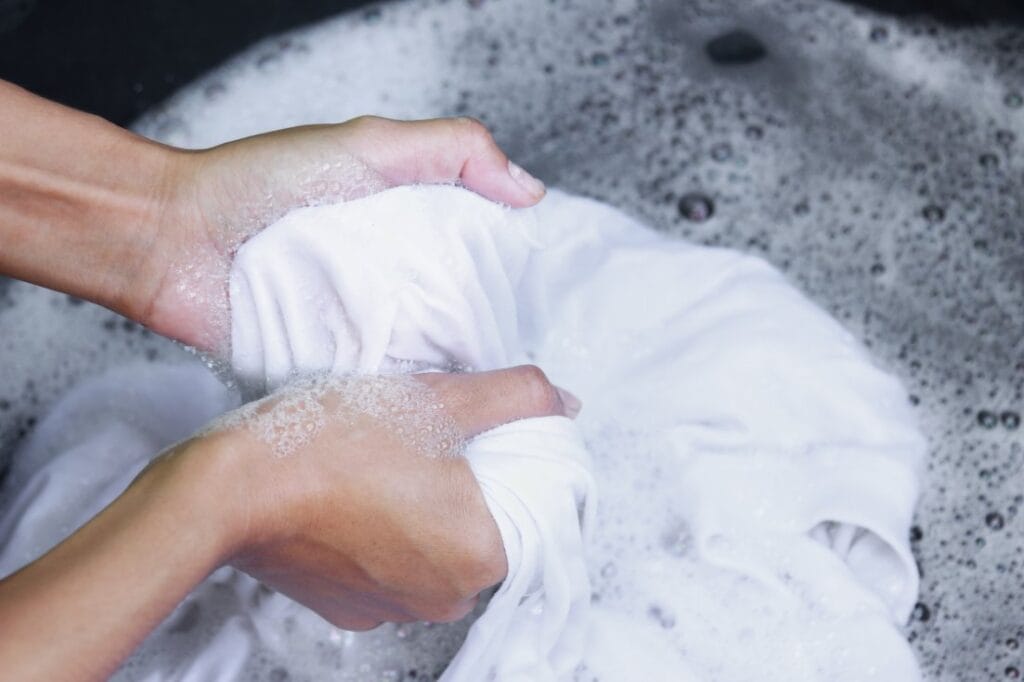
Hand washing is a gentle way to clean polyester, especially for delicate fabrics like polyester dresses or pillowcases. Using the right method helps prevent stretching, fading, or damage.
Preparing Your Polyester for Hand Wash
Start by reading the care label on your polyester garment. Some items, such as dresses or pillowcases, may have specific instructions you should follow.
Use a clean sink or basin. Fill it with cold or lukewarm water. Avoid hot water, as it can weaken the fibers or cause shrinkage.
Add a small amount of mild detergent. Look for one labeled for delicates or sensitive fabrics. Do not use bleach or harsh chemicals as they can damage polyester.
Gently submerge your garment. Swish it around with your hands to distribute the suds. Do not twist or wring the fabric. For stained areas, gently rub with your fingertips until the dirt lifts.
Let the piece soak for up to 30 minutes if needed, especially if the fabric holds odor or is heavily soiled.
Rinsing Techniques for Delicate Fabrics
After washing, drain the soapy water. Refill the basin with clean, cool water to rinse the polyester.
Move the garment through the water gently. Repeat as needed, using fresh water each time, until all detergent is out.
Tip: For extra softness, add a small amount of gentle fabric conditioner to the rinse. This can help keep items like pillowcases and dresses feeling smooth.
Do not wring polyester. Instead, lay the garment flat on a towel and roll it up to press out water. Reshape your item and lay it flat or hang it to air dry.
If your piece needs extra care, avoid direct sunlight and high heat while drying. This prevents fading or unwanted texture changes.
How to Wash Polyester Blankets
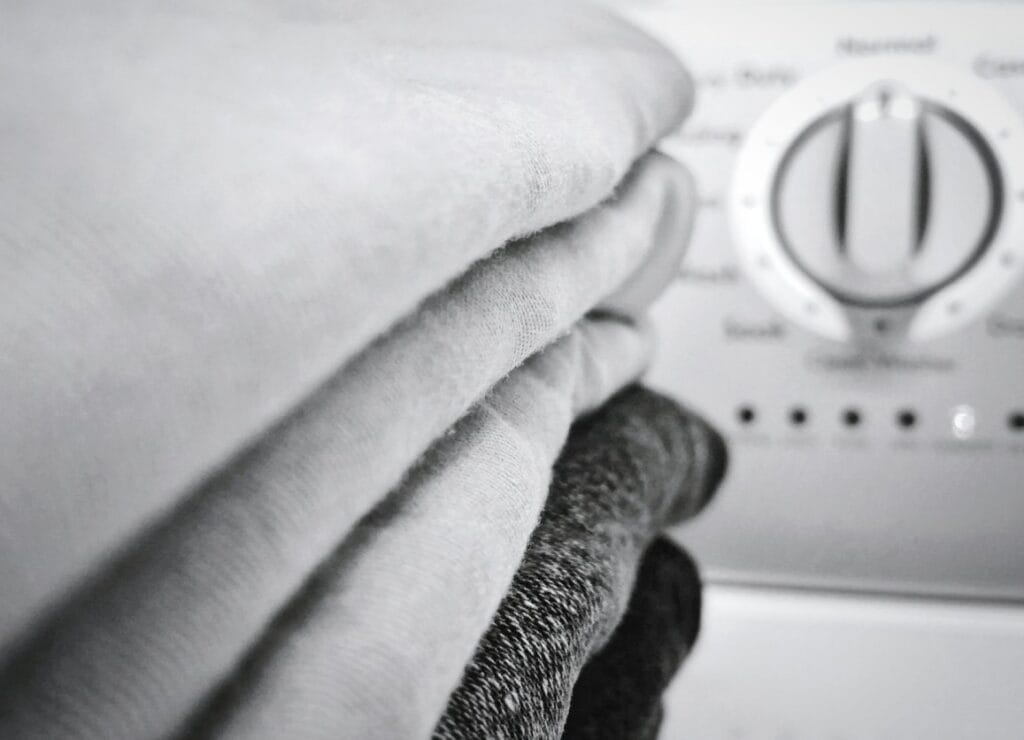
Polyester blankets need special attention due to their size and thickness. Here’s how to wash them properly:
Machine Washing Polyester Blankets
- Check the care label first to confirm machine washing is safe
- Use a large capacity washer to give the blanket room to move
- Select cold or warm water on a gentle cycle
- Add mild detergent but use less than normal since blankets hold more water
- Run an extra rinse cycle to remove all soap residue
How to Wash a 100 Polyester Blanket
For 100% polyester blankets:
- Pre-treat any stains with a gentle stain remover
- Wash alone or with one other blanket to prevent overloading
- Use the bulky items cycle if your machine has one
- Check that the blanket moves freely during the wash
- Air dry when possible to maintain fluffiness
For thick blankets: Consider taking them to a laundromat with large commercial machines for better cleaning.
Understanding Polyester Shrinkage
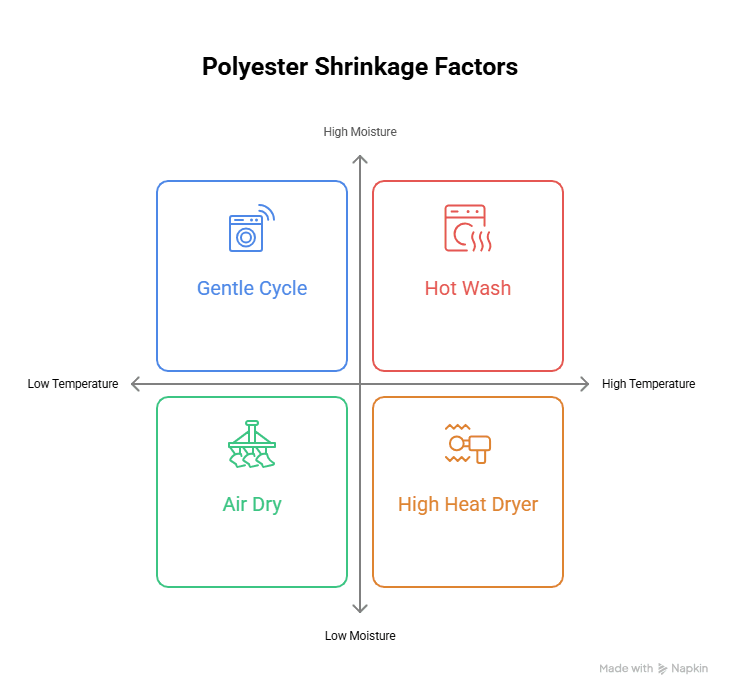
One of the most common questions about polyester care is whether it shrinks. Understanding the science behind polyester shrinkage helps you protect your clothes.
Can 100 Polyester Shrink?
Pure 100% polyester rarely shrinks under normal washing conditions. However, it can shrink if exposed to:
- High heat (hot water or high dryer settings)
- Steam at high temperatures
- Improper ironing with excessive heat
Will 100 Polyester Shrink?
100% polyester is designed to resist shrinkage, but it’s not completely shrink-proof. The amount of shrinkage depends on:
- Manufacturing quality of the fabric
- Fabric weave (knit vs. woven)
- Heat exposure during care
- Original fabric tension during production
Can You Shrink 100 Polyester Intentionally?
If you want to shrink polyester clothing intentionally:
Method 1: Hot Water Wash
- Wash in the hottest water setting
- Use longest wash cycle
- Immediately transfer to high heat dryer
- Dry until completely dry
Method 2: Boiling Water Treatment
- Boil a large pot of water
- Submerge the garment for 10-15 minutes
- Transfer immediately to hot dryer
- Check size frequently to prevent over-shrinking
Warning: These methods may damage the fabric’s texture and color. Test on a small area first.
How Can I Shrink Polyester Safely?
For minimal shrinkage without damage:
- Wash in warm to hot water (not boiling)
- Use medium heat in the dryer
- Check progress every 15 minutes
- Stop when desired size is reached
- Iron with medium heat if additional shrinkage is needed
Will Polyester Shrink in the Dryer?
Yes, polyester can shrink in the dryer if you use:
- High heat settings
- Extended drying times
- Overdrying beyond completely dry
Prevention tips:
- Use low to medium heat
- Remove while slightly damp
- Check clothing every 20 minutes
Drying Polyester Properly
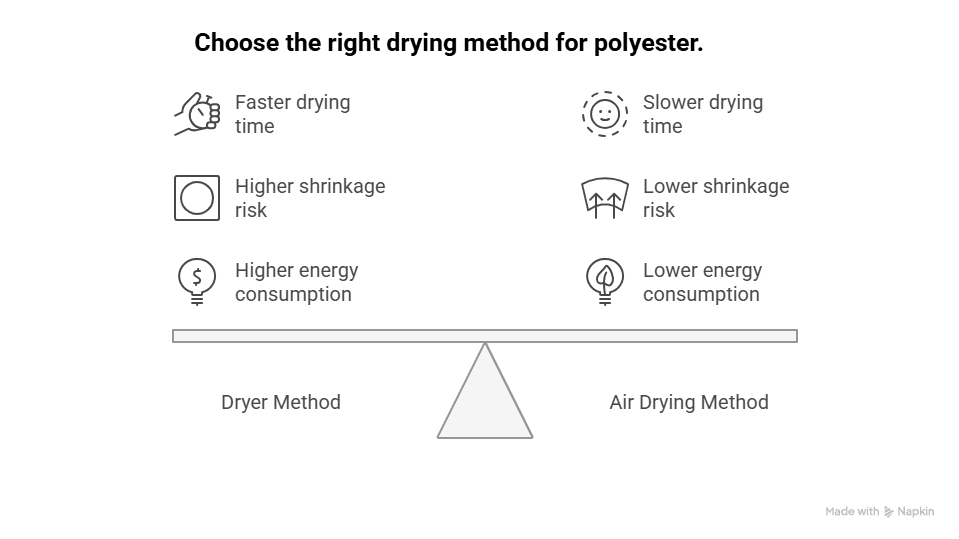
To keep your polyester clothing looking good, you need to use the right drying method. Both using a dryer and air drying have pros and cons, and choosing the correct temperature is important for avoiding damage or shrinkage.
Can You Put Polyester in the Dryer?
Yes, you can put polyester in the dryer safely when you use the correct settings. Polyester is designed to handle machine drying, but heat control is essential.
Can You Dry 100 Polyester?
100% polyester can be machine dried using these guidelines:
- Low to medium heat settings
- Permanent press cycle
- Remove promptly when dry
- Avoid overdrying
How to Dry 100 Polyester
Follow this step-by-step process:
- Shake out garments before placing in dryer
- Select low to medium heat
- Use dryer sheets to reduce static
- Set timer for 30-45 minutes
- Check dryness every 15 minutes
- Remove immediately when dry
Using a Dryer Safely
You can safely put 100% polyester in a dryer if you use the right settings. Polyester is heat sensitive, so use a low or medium heat setting. High heat can cause the fibers to melt or shrink.
It’s best to remove items promptly after the cycle ends. This helps prevent wrinkles. The normal dry cycle for polyester takes about 45 minutes but always check your label in case your item needs less time.
If you’re worried about static, you can add a dryer sheet. Avoid drying with towels or heavy fabrics, since they may trap moisture and leave polyester damp. Shake out clothes before folding or hanging.
Air Drying Techniques
If you want to be extra careful, air drying is a gentle way to dry polyester clothing. First, gently reshape the item and lay it flat on a clean, dry towel or hang it on a padded hanger. Avoid direct sunlight, which can fade colors.
Air drying helps prevent heat damage and keeps your clothes from shrinking. Make sure air can circulate on all sides. If drying indoors, put the item in a well-ventilated area, like near a fan or window.
Don’t wring out polyester; instead, press out excess water with a towel. Let heavy items dry flat to keep them from stretching. Light shirts or blouses can hang without problems.
Air Drying Benefits:
- No shrinkage risk
- Energy savings
- Prevents heat damage
- Reduces static buildup
- Extends fabric life
Avoiding Polyester Shrinkage
The main cause of polyester shrinkage is exposure to high heat. Always check the clothing label and set your dryer or iron to a low or medium temperature. Avoid steam settings if possible.
Stick to these tips:
- Tumble dry on low heat
- Air dry if you are concerned about size changes
- Never use hot water during washing
- Remove from dryer while slightly damp
If you notice your polyester garment has shrunk, it usually cannot be stretched back to its original size. Preventing shrinkage is easier than fixing it afterward, so always dry with care and follow the label instructions closely.
Ironing and Steaming Polyester

Polyester’s wrinkle-resistant nature means it rarely needs ironing, but when it does, proper technique is crucial to avoid damage.
Can You Iron 100 Polyester?
Yes, you can iron 100% polyester, but it requires careful temperature control. Polyester melts at relatively low temperatures compared to natural fibers.
Can You Iron Polyester Fabric?
Most polyester fabrics can be ironed safely when you:
- Use low heat settings (silk/synthetic setting)
- Iron on the wrong side of the fabric
- Use a pressing cloth for extra protection
- Keep the iron moving to prevent heat buildup
How to Iron 100 Polyester
Step-by-step ironing process:
- Set iron to low heat (around 275°F or silk setting)
- Turn garment inside out
- Place pressing cloth over the fabric
- Use smooth, gliding motions
- Don’t leave iron in one spot
- Check frequently for heat damage
How to Iron Polyester Safely
Safety guidelines:
- Test on hidden area first
- Never use steam on high heat
- Keep iron moving constantly
- Use distilled water in steam iron
- Iron while slightly damp for best results
What Setting to Iron Polyester?
The correct iron settings for polyester:
| Iron Setting | Temperature | When to Use |
|---|---|---|
| Silk/Synthetic | 275°F (135°C) | Standard polyester |
| Low | 250°F (120°C) | Delicate polyester |
| Medium | 300°F (150°C) | AVOID |
| High | 400°F+ | NEVER USE |
What Temperature to Iron Polyester?
The ideal temperature range for ironing polyester is 250-275°F (120-135°C). This is hot enough to remove wrinkles but cool enough to prevent melting.
Temperature warning signs:
- Shiny marks indicate too much heat
- Fabric puckering means temperature too high
- Melting or sticking requires immediate cooling
Can You Steam Polyester?
Yes, steaming is often safer than ironing for polyester because the steam doesn’t make direct contact with the fabric.
Can You Steam 100 Polyester?
100% polyester responds well to steaming when done correctly:
- Use medium steam settings
- Keep steamer moving
- Maintain 6-8 inch distance
- Work from top to bottom
- Allow fabric to cool before handling
Can You Steam Polyester Fabric?
Most polyester fabrics can be steamed safely. Steaming benefits include:
- No direct heat contact
- Gentler than ironing
- Reduces static
- Refreshes between washes
- Removes light wrinkles
Steaming technique:
- Hang garment properly
- Fill steamer with distilled water
- Allow steamer to heat up
- Steam in downward motions
- Let fabric dry completely
Fabric Softener and Polyester
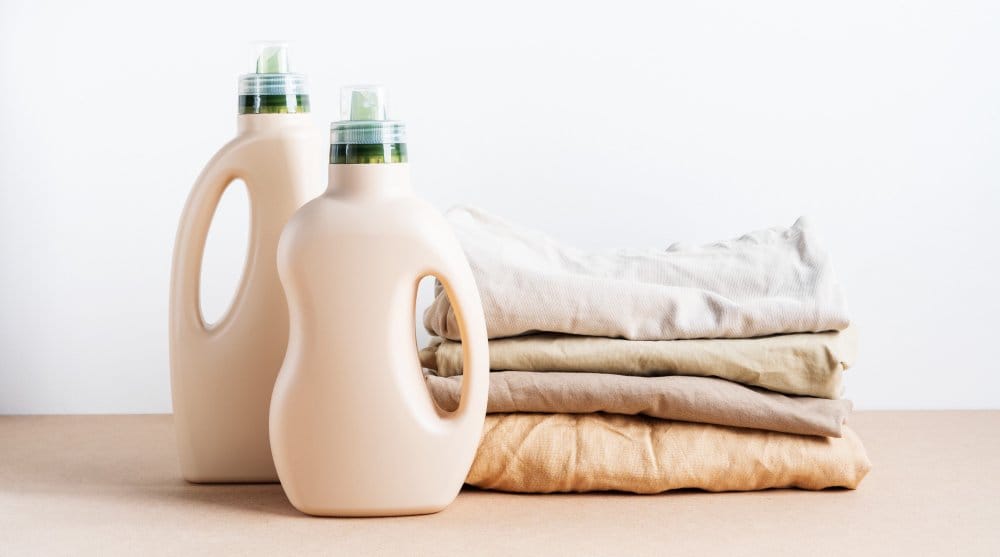
The relationship between fabric softener and polyester is complex and requires careful consideration.
Can I Use Fabric Softener on Polyester?
You can use fabric softener on polyester, but it’s not always recommended. Fabric softener can:
Benefits:
- Reduce static cling
- Add softness
- Provide pleasant scent
- Reduce wrinkles
Drawbacks:
- Build up on fibers
- Reduce moisture-wicking in athletic wear
- Attract dirt and oils
- Cause fabric to feel stiff over time
Should I Use Fabric Softener on Polyester?
Whether to use fabric softener depends on the type of polyester item:
Use fabric softener for:
- Regular clothing (shirts, pants, dresses)
- Bedding and pillowcases
- Items with static problems
- Non-athletic wear
Avoid fabric softener for:
- Athletic and sportswear
- Moisture-wicking fabrics
- Technical outdoor gear
- Items worn next to skin during exercise
How to Soften Polyester Fabric
Alternative methods to soften polyester without fabric softener:
Natural alternatives:
- White vinegar – Add 1/2 cup to rinse cycle
- Baking soda – Add 1/4 cup to wash cycle
- Wool dryer balls – Reduce static and soften naturally
- Air drying – Prevents stiffness from overdrying
Commercial alternatives:
- Dryer sheets (use sparingly)
- Liquid fabric softener (diluted)
- Fabric spray between washes
Advanced Stain Removal for Polyester
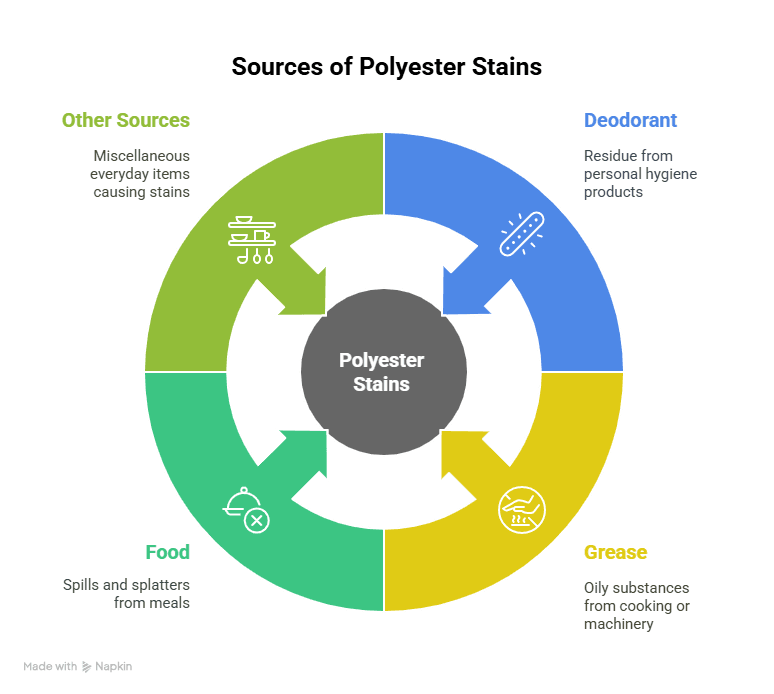
Polyester can pick up stains from deodorant, grease, food, and other common sources. These stains often need special care and methods for the best results, but most are easy to handle with the right products and techniques.
Removing Deodorant Stains from Polyester
Deodorant stains can leave white marks or a buildup on the underarms of polyester shirts. To treat these stains, turn the clothing inside out so you can see the stain directly.
Mix a paste using baking soda and a small amount of water. Apply the paste to the stained area. Gently rub the fabric together or use a soft toothbrush to help the paste work into the fabric. Let it sit for 15 to 30 minutes.
Rinse the area with cold water. Wash the polyester garment in cool or warm water with standard detergent. If the stain remains, use a bit of white vinegar or a stain remover spray before washing again. Air dry, as heat can set deodorant stains.
Oil-Based Stains (Makeup, Cooking Oil, Salad Dressing)
Oil stains are challenging because polyester attracts oils strongly:
Immediate treatment:
- Blot excess oil with paper towel
- Apply dish soap directly to stain
- Work in gently with fingers
- Let sit for 15 minutes
- Rinse with cool water
- Wash normally
For set-in oil stains:
- Pre-treat with enzyme detergent
- Soak overnight in cool water
- Use oxygen bleach if safe for colors
- Repeat treatment if needed
Protein Stains (Sweat, Blood, Grass)
Protein-based stains need enzyme action:
Treatment method:
- Rinse with cold water immediately
- Apply enzyme detergent directly
- Soak for 30 minutes
- Rub gently with soft brush
- Wash in cool water
- Air dry to check results
Tannin Stains (Coffee, Tea, Wine, Fruit Juice)
These stains can be tricky but respond to acidic treatments:
Fresh tannin stains:
- Rinse immediately with cold water
- Apply white vinegar to stain
- Let sit for 10 minutes
- Rinse thoroughly
- Wash normally
Set-in tannin stains:
- Make paste with baking soda and water
- Apply and let sit for 1 hour
- Rinse and apply lemon juice
- Wash with enzyme detergent
Ink and Pen Marks
Ink requires solvent-based treatment:
Method:
- Place paper towel under stain
- Dab with rubbing alcohol (don’t rub)
- Let alcohol work for 5 minutes
- Blot with clean cloth
- Rinse with cold water
- Wash immediately
Set-in Stains
Old stains that have been through the dryer need aggressive treatment:
Intensive treatment:
- Soak overnight in enzyme detergent solution
- Make paste with oxygen bleach and water
- Apply to stain and let sit 2 hours
- Scrub gently with soft brush
- Rinse thoroughly
- Wash in hottest safe water
- Air dry and repeat if needed
Seasonal Care Tips

Different seasons require adjusted care approaches for polyester garments.
Winter Polyester Care
Indoor drying challenges:
- Use humidifier to reduce static
- Space items apart for air circulation
- Rotate drying position regularly
- Avoid direct heat sources
Static prevention:
- Add dryer sheets to loads
- Use fabric softener sparingly
- Install humidifier in laundry area
- Store with dryer sheets
Summer Polyester Care
Sweat stain prevention:
- Pre-treat underarms before washing
- Use antiperspirant rather than deodorant
- Wash after each wear in hot weather
- Apply stain guard to new garments
UV protection:
- Dry in shade when possible
- Turn garments inside out when line drying
- Use UV-protective detergent
- Store away from windows
Athletic Wear Maintenance
Pre-wash treatment:
- Rinse in cold water immediately after exercise
- Pre-treat with enzyme detergent
- Turn inside out for washing
- Don’t let sit wet for extended periods
Washing guidelines:
- Use sport-specific detergent
- Wash in cold water
- Skip fabric softener
- Air dry when possible
Troubleshooting Common Problems
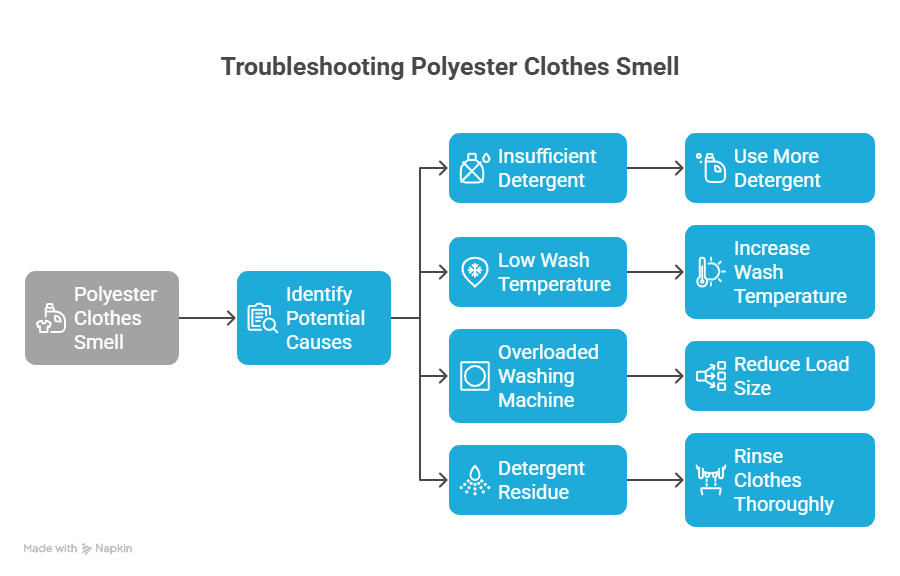
“My Polyester Clothes Smell After Washing”
Causes and solutions:
- Insufficient detergent
- Increase detergent amount slightly
- Use enzyme detergent for protein-based odors
- Add baking soda to wash cycle
- Overloading washer
- Wash smaller loads
- Ensure proper water circulation
- Use appropriate water level
- Detergent buildup
- Run extra rinse cycle
- Use less detergent
- Clean washing machine monthly
- Bacteria growth
- Wash in hottest safe water
- Add white vinegar to rinse
- Dry completely before storing
Polyester Fabric Pilling Prevention
Prevention strategies:
- Turn garments inside out
- Use mesh laundry bags
- Wash similar fabrics together
- Avoid overloading washer
- Use gentle cycle
Removal methods:
- Use fabric shaver carefully
- Try pumice stone for light pilling
- Use razor blade with extreme caution
- Consider professional cleaning
Static Cling in Polyester Clothes
Prevention:
- Use dryer sheets
- Add fabric softener to rinse
- Don’t overdry
- Increase room humidity
Quick fixes:
- Spray with water lightly
- Rub with dryer sheet
- Use anti-static spray
- Pin safety pin to inside seam
Polyester Clothes Losing Shape
Prevention:
- Don’t stretch when wet
- Dry flat or hang properly
- Use appropriate hangers
- Store folded for knits
Restoration:
- Steam gently to relax fibers
- Reshape while damp
- Iron with pressing cloth
- Consider professional cleaning
Color Fading in Polyester Garments
Prevention:
- Wash in cold water
- Turn inside out
- Use color-safe detergent
- Avoid direct sunlight when drying
Restoration:
- Use color-reviving detergent
- Try fabric dye for solid colors
- Professional dyeing services
- Accept natural aging
Environmental Considerations and Sustainability
Microplastic Reduction Techniques
Polyester sheds microplastics during washing, which enter water systems:
Reduction methods:
- Use microfiber-catching bags like Guppyfriend
- Install washing machine filters
- Wash less frequently when possible
- Choose high-quality polyester that sheds less
- Use cold water to reduce fiber release
Eco-Friendly Detergent Recommendations
Environmentally conscious options:
- Plant-based detergents
- Concentrated formulas
- Phosphate-free options
- Biodegradable ingredients
- Minimal packaging
Energy-Efficient Washing Methods
Energy-saving tips:
- Wash in cold water when possible
- Use high-efficiency machines
- Wash full loads but don’t overpack
- Air dry instead of machine drying
- Clean lint filters regularly
Extending Garment Lifespan
Longevity strategies:
- Rotate wearing to reduce stress
- Proper storage prevents damage
- Prompt stain treatment
- Gentle washing methods
- Professional cleaning for special items
Professional vs Home Care

When to Choose Professional Cleaning
Consider professional care for:
- Expensive or delicate items
- Structured garments (blazers, suits)
- Items with embellishments
- Stubborn stains that resist home treatment
- Items labeled “dry clean only”
Cost Comparison
Home washing costs:
- Water and energy: $0.50-1.00 per load
- Detergent: $0.25-0.50 per load
- Total: $0.75-1.50 per load
Professional cleaning costs:
- Dry cleaning: $3-8 per item
- Specialty cleaning: $5-15 per item
- Alterations/repairs: $10-50+
Quality Differences in Cleaning Methods
Home washing advantages:
- Cost effective for regular items
- Convenient timing
- Control over products used
- Immediate availability
Professional cleaning advantages:
- Specialized equipment
- Expert stain removal
- Pressing and shaping
- Damage protection
Equipment-Specific Guidelines
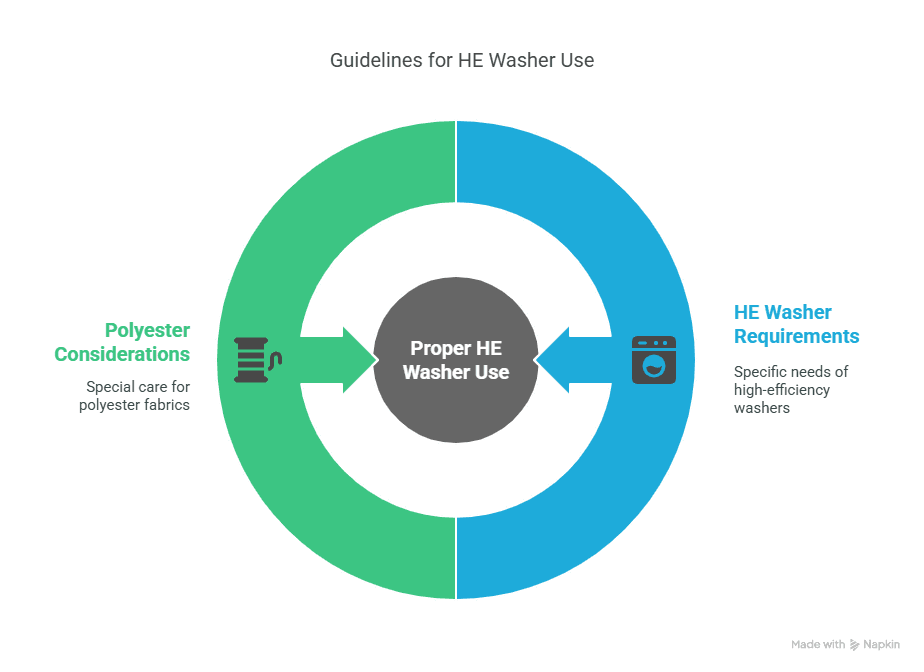
High-Efficiency (HE) Washer Instructions
HE washers require special considerations for polyester:
Detergent adjustments:
- Use HE-specific detergents
- Reduce amount by 25%
- Avoid regular detergents (too sudsy)
- Add detergent to drawer not drum
Cycle modifications:
- Select synthetic or delicate cycle
- Use extra rinse option
- Avoid quick wash for heavily soiled items
Commercial Laundromat Tips
Equipment selection:
- Choose newer machines
- Use large capacity for bulky items
- Check cleanliness before use
- Test water temperature
Process adjustments:
- Bring your own detergent
- Monitor wash progress
- Remove promptly when finished
- Inspect for damage before leaving
How to Wash Polyester Jackets
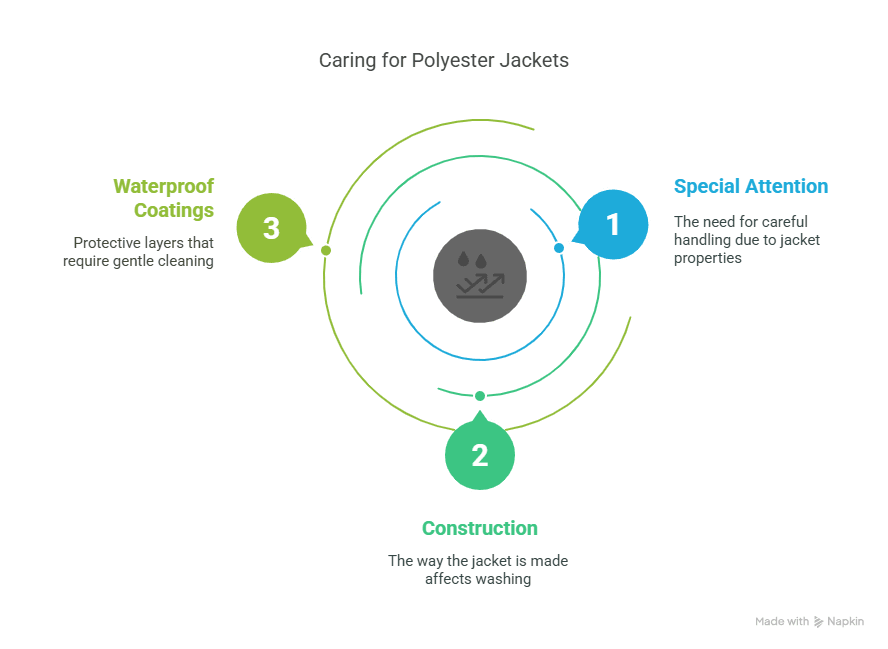
Polyester jackets require special attention due to their construction and often waterproof coatings.
Preparation Steps
Before washing:
- Check all pockets for items
- Close all zippers and fasteners
- Turn inside out if no special coating
- Pre-treat stains on collar and cuffs
- Read care label for specific instructions
Washing Process
Machine washing:
- Use gentle cycle with cold water
- Add mild detergent (avoid fabric softener)
- Wash alone or with similar items
- Use mesh bag for lightweight jackets
- Select extra rinse to remove all soap
Hand washing delicate jackets:
- Fill basin with cool water
- Add gentle detergent
- Soak for 15 minutes
- Gently swish without wringing
- Rinse thoroughly multiple times
Drying Techniques
Air drying (preferred):
- Hang on padded hanger
- Reshape while damp
- Avoid direct sunlight
- Ensure good air circulation
Machine drying (if care label allows):
- Use low heat only
- Add clean tennis balls for fluffiness
- Check every 20 minutes
- Remove while slightly damp
Caring for Polyester Blends and Special Items

Polyester blends, delicate fabrics, and special items like bedding need specific care to avoid damage or shrinking. Using the right cycle and temperature will help keep your clothes and linens in good shape.
Washing Polyester Blends
When washing polyester blends such as a cotton-polyester blend, always check the care label because the cotton content may need cooler water or gentler cycles. Use a mild detergent and set your machine to cold or warm water to help prevent shrinking or stretching.
Common blend ratios and care:
| Blend Type | Care Instructions | Special Notes |
|---|---|---|
| 50/50 Cotton-Poly | Warm water, medium heat dry | May shrink slightly |
| 65/35 Poly-Cotton | Cold to warm water, low heat | More stable than cotton-heavy |
| Tri-blend (Cotton/Poly/Rayon) | Cold water, air dry preferred | Most delicate blend |
| Poly-Spandex | Cold water, low heat or air dry | Never use fabric softener |
Avoid hot water, which can harm both the polyester and cotton fibers. A gentle cycle will protect the fabric’s shape. After washing, hang items to air dry or use a low-heat setting in the dryer. Remove clothes quickly to prevent wrinkles.
For stains, pretreat before washing. Avoid bleach, as it can weaken both polyester and cotton fibers over time.
Handling Delicate or Embellished Polyester
Delicate fabrics, such as chiffon or polyester clothes with beads, sequins, or lace, need extra care. Wash these by hand in cool water with a small amount of gentle detergent. Gently agitate the water instead of scrubbing or twisting the fabric.
If you must use a machine, place the item inside a mesh laundry bag and use a delicate or gentle cycle with cold water. Always skip the dryer and air dry these garments flat or on a drying rack to avoid stretching and damage to the embellishments.
For ironing, use the lowest heat setting and always place a cloth over the fabric to prevent melting.
Tips for Washing Bedding and Pillowcases
Bedding and pillowcases made from polyester or polyester blends should be washed on a regular cycle with cold or warm water. Use a standard detergent and avoid fabric softeners, which can build up and reduce the fabric’s breathability.
Wash bedding alone or with other linens to prevent snagging. Shake out pillowcases before drying to help them stay smooth. Dry on a low-heat setting or hang to air dry. Overdrying in a hot dryer can cause wrinkles and make the fabric feel stiff.
For the best results, remove bedding from the dryer while still slightly damp and finish air drying, which helps prevent static and reduces wrinkles.
Quick Reference Guide
🧺 Polyester Care Flowchart
💡 Quick Tips
- Always turn garments inside out before washing
- Never use hot water or high heat settings
- Avoid fabric softener on athletic wear
- Use mesh bags for delicate polyester items
- Act quickly on stains for best results
Emergency Stain Treatment Guide
Immediate action for common stains:
- Oil/Grease: Blot, apply dish soap, rinse cold
- Blood: Rinse cold immediately, enzyme detergent
- Coffee/Tea: Rinse cold, apply white vinegar
- Ink: Dab with rubbing alcohol, don’t rub
- Sweat: Pre-treat with baking soda paste
Expert Advice and Reliable Resources
Polyester is durable, but specific stains or concerns may require extra steps or expert opinions. Relying on trustworthy sources helps you avoid errors that could damage your clothing.
When to Consult Verified Experts
If you face issues like stubborn stains, noticeable color bleeding, or shrinking, you may need professional help. Verified experts such as dry cleaners and textile specialists can guide you when regular washing tips do not work. They use their experience to assess fabric problems and give you safe instructions.
Websites like JustAnswer let you ask specific questions to experts in real time. You can upload photos or describe your issue to get tailored advice. This is especially helpful if your polyester item is expensive, sentimental, or has unique care instructions on its label. Getting personalized input can prevent accidental damage.
Trustworthy Online Information Sources
Online guides from appliance brands (like Whirlpool) and laundry professionals (like The Laundress) offer trustworthy instructions for washing polyester. These sources clearly list recommended water temperatures, washing cycles, and detergents to use. The American Cleaning Institute provides science-based fabric care information.
Look for tips backed by science, detailed instructions, and positive user feedback. If a website allows users to interact with verified experts, like JustAnswer, the information is more likely to be accurate. Use official brand and expert websites for the most up-to-date and reliable care advice. Check for clear, specific directions so you do not accidentally harm your polyester items.
Conclusion
Caring for 100% polyester doesn’t have to be complicated, but understanding the right techniques makes all the difference in keeping your clothes looking great and lasting longer. Throughout this comprehensive guide, we’ve covered everything from basic washing principles to advanced stain removal and troubleshooting common problems.
The key takeaways for successful polyester care are straightforward: always use cool to warm water, choose gentle cycles, avoid high heat in both washing and drying, and pay attention to care labels. Remember that polyester is heat-sensitive, so the “low and slow” approach works best for maintaining the fabric’s integrity and appearance.
Essential recommendations to remember:
For everyday care: Wash polyester in cold or warm water using a gentle cycle with mild detergent. Turn garments inside out to prevent pilling and protect the outer surface. Air dry when possible, or use low heat settings in the dryer.
For stain removal: Act quickly on spills and stains. Pre-treat with appropriate solutions based on the stain type, and never use hot water or high heat on stained items as it can set the stain permanently.
For longevity: Rotate your polyester garments to reduce wear, store them properly, and address problems like odors or pilling promptly. Using mesh laundry bags for delicate items and avoiding fabric softener on athletic wear will help maintain their performance and appearance.
For environmental responsibility: Consider using microfiber-catching bags to reduce microplastic pollution, choose eco-friendly detergents when possible, and extend garment life through proper care to reduce textile waste.
The beauty of polyester lies in its durability and easy-care nature, but these benefits are only realized when you treat the fabric correctly. Whether you’re caring for everyday clothing, athletic wear, bedding, or special garments, the principles remain consistent: gentle treatment, appropriate temperatures, and prompt attention to problems.
By following the guidelines in this comprehensive guide, you’ll not only keep your polyester items looking their best but also save money by extending their lifespan and avoiding costly replacements. Remember that when in doubt, it’s always better to err on the side of caution with gentler settings and cooler temperatures.
Take the time to read care labels, invest in quality detergents suitable for synthetic fabrics, and don’t hesitate to seek professional help for valuable or delicate items. With proper care, your polyester garments can maintain their appearance, comfort, and functionality for years to come, making them a smart and sustainable choice for your wardrobe.
Frequently Asked Questions (FAQs)
Can you put 100% polyester in the dryer?
Yes, you can put 100% polyester in the dryer safely. Use low to medium heat settings and remove items promptly when dry. Avoid high heat as it can cause shrinkage or melting.
What happens if you wash polyester in hot water?
Washing polyester in hot water can cause the fibers to break down, leading to shrinkage, loss of shape, and weakened fabric. The synthetic fibers may also become more prone to static and pilling.
Does polyester shrink in the washing machine?
Pure 100% polyester rarely shrinks in normal washing conditions. However, it can shrink if exposed to hot water or high heat during drying. Polyester blends with cotton or other natural fibers are more likely to shrink.
Can you iron polyester clothing?
Yes, but use the lowest heat setting (silk/synthetic setting around 275°F). Always iron on the wrong side of the fabric or use a pressing cloth to prevent melting or shiny marks.
How often should you wash polyester clothes?
Wash polyester clothes after each wear for items worn close to the skin or during physical activity. Outer layers like jackets or sweaters can be worn 2-3 times before washing if they’re not soiled or smelly.
Is polyester machine washable?
Yes, most polyester items are machine washable. Check the care label first, but the majority of polyester clothing can be safely washed in a regular washing machine using appropriate settings.
Can you steam polyester fabric?
Yes, steaming is often safer than ironing for polyester. Use medium steam settings and keep the steamer moving to avoid heat damage. Maintain a 6-8 inch distance from the fabric.
Should I use fabric softener on polyester?
It depends on the item. Use fabric softener sparingly on regular polyester clothing for softness and static reduction. Avoid it completely on athletic wear or moisture-wicking fabrics as it reduces their performance.
Can polyester be dry cleaned?
Yes, polyester can be dry cleaned, especially items labeled “dry clean only.” However, most polyester items can be safely washed at home unless they have special construction or embellishments.
Why does my polyester smell after washing?
Polyester can retain odors due to its synthetic nature. This usually happens from insufficient detergent, overloading the washer, or bacteria buildup. Try using enzyme detergent, washing in smaller loads, or adding white vinegar to the rinse cycle.
Can you bleach 100% polyester?
Never use chlorine bleach on polyester as it can cause discoloration and weaken the fibers. Oxygen bleach is safe for white polyester items and can help remove stains without damage.
How do you remove static from polyester clothes?
Reduce static by using dryer sheets, not overdrying clothes, adding fabric softener to the rinse cycle, or using wool dryer balls. For immediate relief, lightly spray with water or rub with a dryer sheet.

